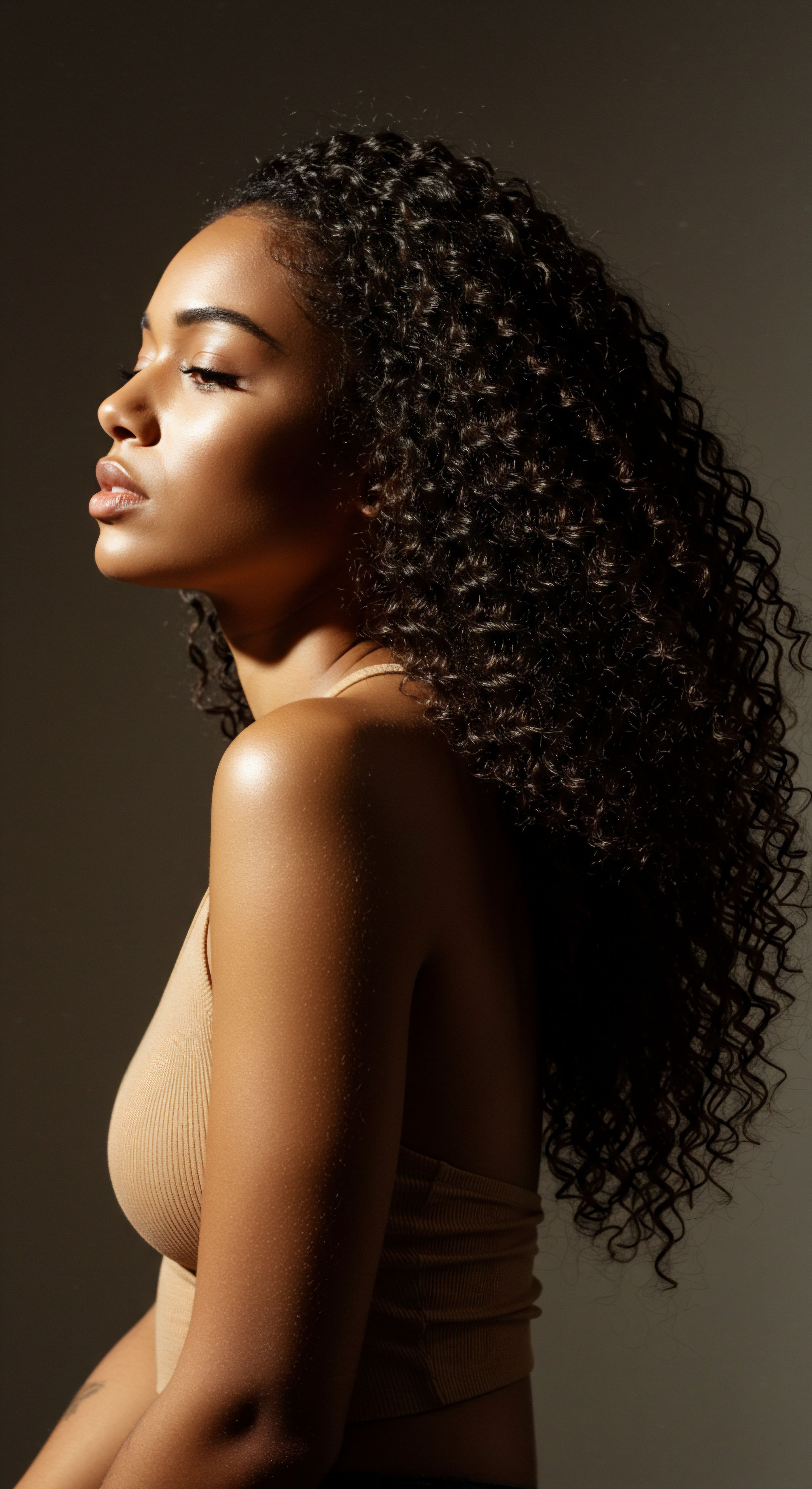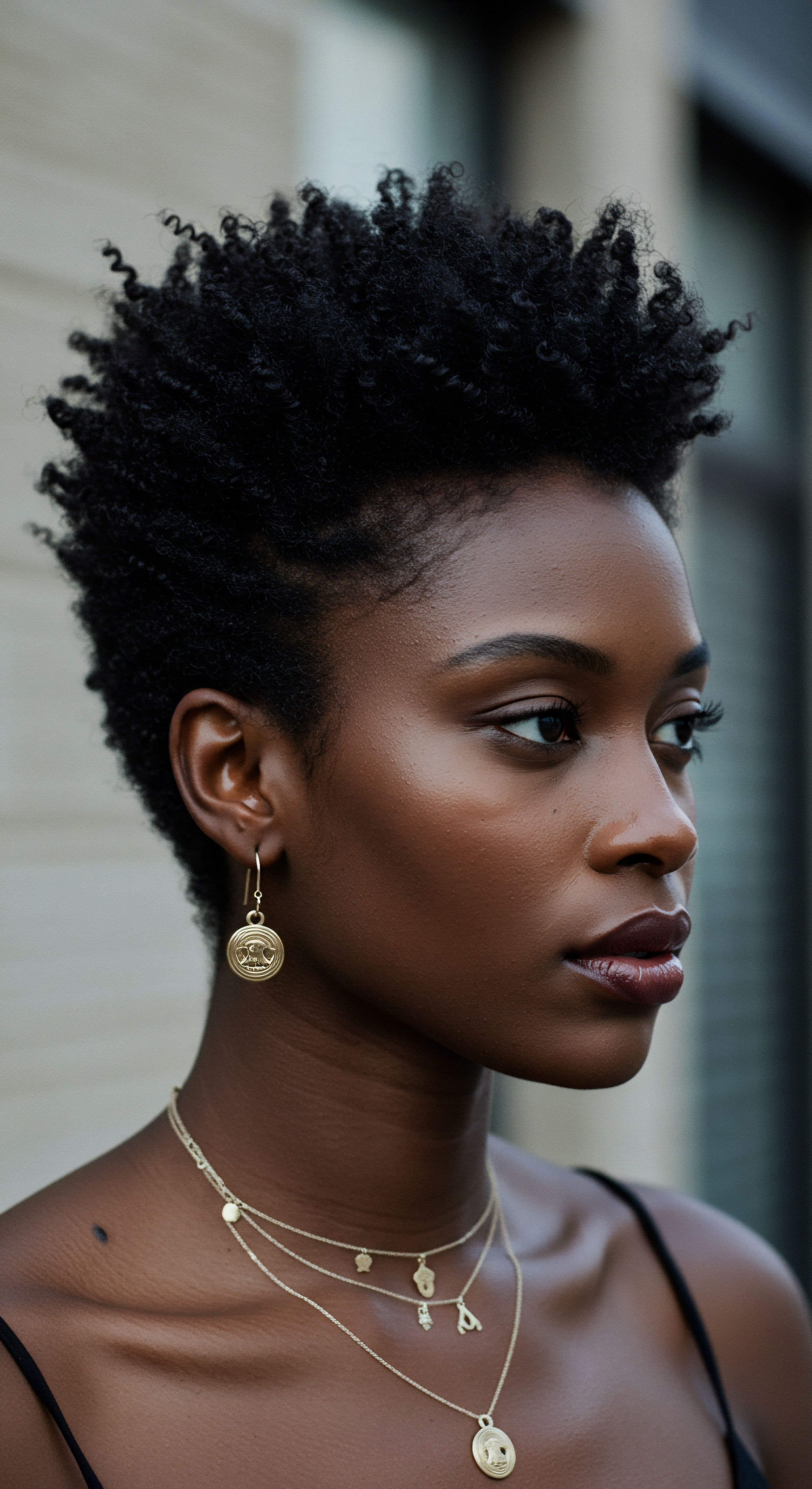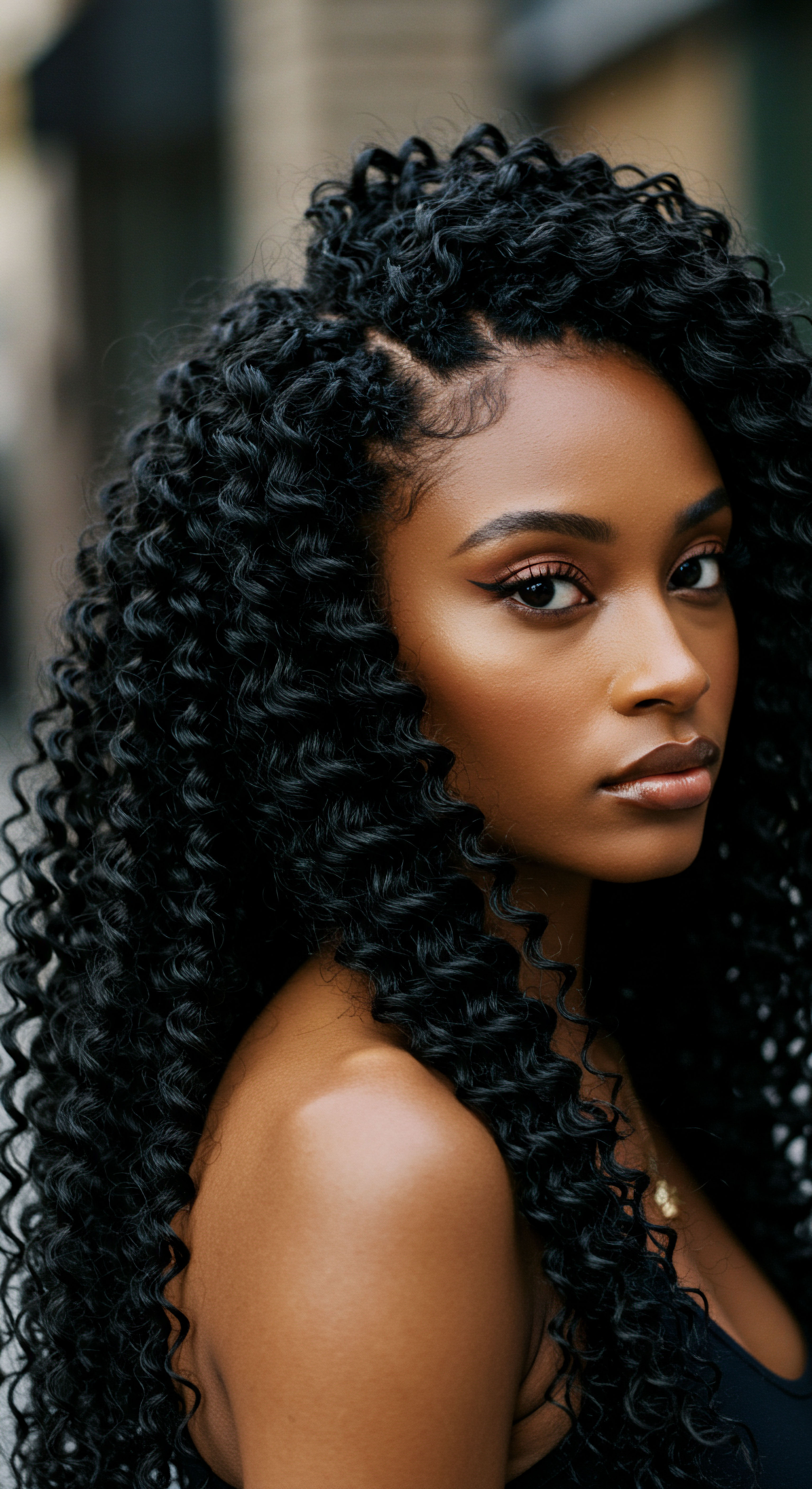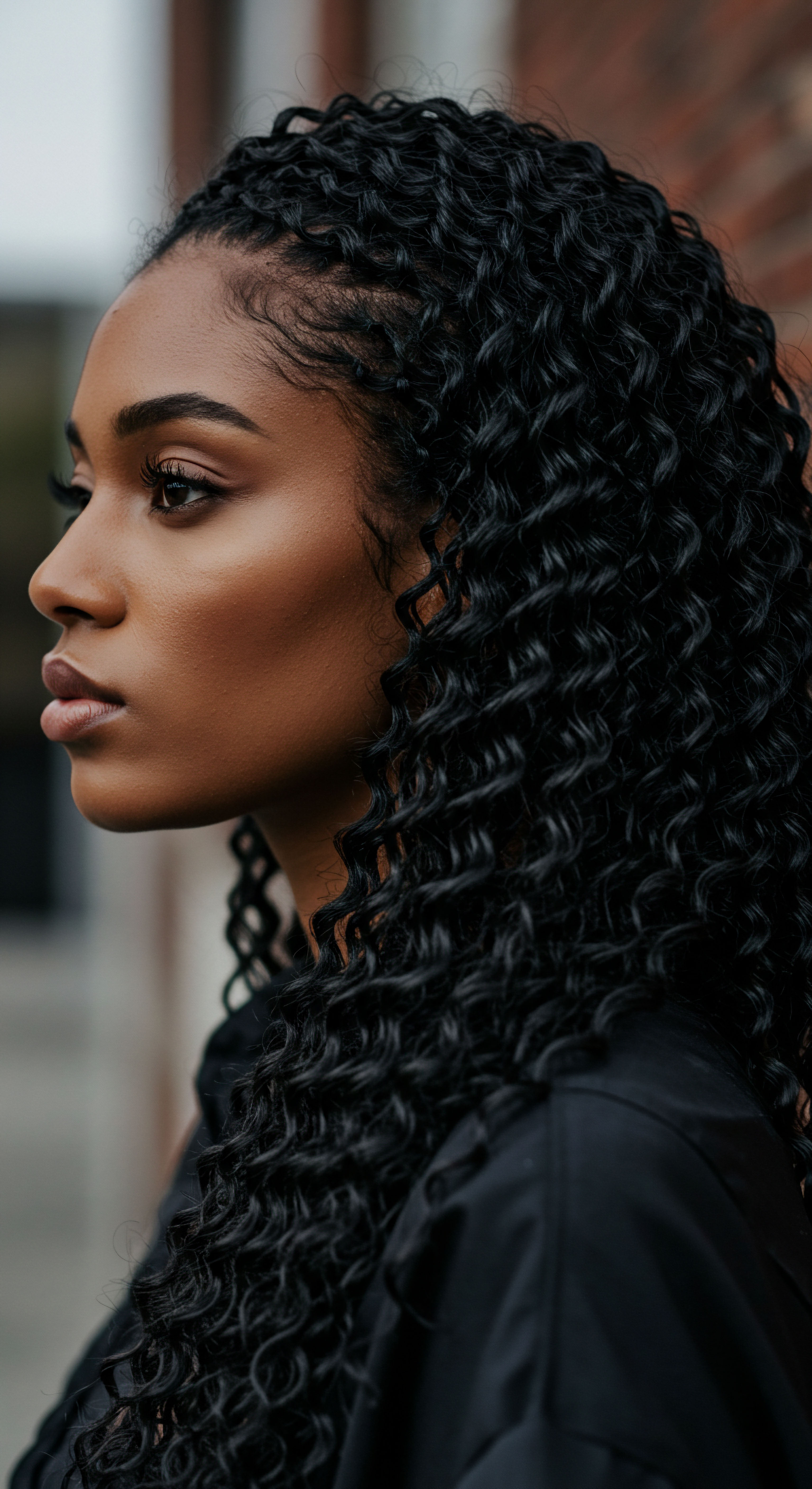
Roots
Consider for a moment the silent wisdom held within each strand, a heritage stretching back through generations, a legacy whispered in the gentle brush strokes of evening care. Long before the advent of modern science, humanity understood hair not merely as a biological extension, but as a living record, a profound connection to ancestry, community, and the spiritual realm. This innate understanding, passed down through the ages, shaped practices that honored hair’s deep significance, particularly as day surrendered to night. The way hair is treated during these quiet hours often reflects a civilization’s deepest beliefs about vulnerability, protection, and renewal.
From the earliest communal gatherings around fires to the quiet solitude of personal chambers, nighttime brought with it a shift in perspective. Hair, exposed throughout the day to elements and energies, required specific attention before rest. These practices were not born of arbitrary whim; they emerged from an intuitive recognition of hair’s delicate nature and its symbolic weight. The knowledge of how to tend to one’s hair at night became a shared language, a communal understanding of care that transcended mere physical appearance.

Hair as a Sacred Adornment
Across diverse global societies, hair has long served as a powerful visual marker, a declaration of identity, status, and spiritual connection. In many African cultures, for example, hair was revered as the highest point of the body, a conduit to the divine, capable of receiving and transmitting energy. This reverence extended to how hair was handled, especially during periods of rest.
Styles communicated age, marital status, and tribal affiliation, each twist and braid carrying a specific message. Protecting these intricate expressions of self during sleep was not merely practical; it was an act of preserving one’s essence.
Similarly, in various Indigenous traditions of the Americas, hair is often seen as a manifestation of spiritual strength and a link to the natural world. Long hair, in particular, carries immense symbolic value, representing wisdom and a connection to ancestral spirits. The care given to hair, including its nightly preparation, reflected this deep respect for both personal and collective spiritual well-being. The act of tending to hair before sleep became a quiet reaffirmation of these connections, a moment of grounding before the unconscious world unfolded.

Early Protective Practices
The practical necessity of protecting hair from damage during sleep has been recognized for centuries, predating our scientific understanding of cuticle layers and friction. Early societies observed how hair could tangle, break, or become soiled overnight. These observations led to ingenious solutions, often employing readily available natural materials.
- Wraps ❉ Various forms of head coverings, from simple cloths to elaborately tied wraps, served as a primary means of shielding hair during sleep. These coverings kept hair contained, preventing knots and preserving styles.
- Braiding ❉ Simple or complex braiding patterns were used to secure hair, reducing its exposure to friction against sleeping surfaces. This method also helped maintain texture and prevent tangling.
- Oils ❉ Natural oils derived from plants and seeds were applied to strands, providing a protective coating. This helped to keep hair supple and reduce dryness that could lead to breakage.
These early protective methods, though seemingly simple, formed the bedrock of nighttime hair care. They demonstrate an ancient, intuitive understanding of hair’s fragility and the need for mindful preparation before periods of rest. This foundational knowledge, born of observation and communal wisdom, laid the groundwork for the more complex rituals that would follow.
Hair care, from its ancient origins, embodies a deep understanding of hair’s symbolic value and its need for protective care, especially during sleep.

Ritual
As our understanding of hair deepened, so too did the practices surrounding its nightly care, transforming simple acts into meaningful rituals. The transition from day to night often brought a shift in the way individuals approached their hair, recognizing the hours of sleep as a period of rest and renewal not only for the body but for the hair itself. These practices became interwoven with daily rhythms, shaping routines that speak to both practicality and profound cultural significance. The deliberate movements, the chosen materials, and the quiet intentions all contribute to a sense of purpose, guiding strands through the night.

The Silent Guardians of Sleep
Among the most prominent and enduring nighttime hair care practices is the use of head coverings. Across African cultures and within the African diaspora, the headwrap, or later, the bonnet, evolved beyond a mere fashion statement or daytime adornment. It became a practical necessity for preserving hairstyles and maintaining hair health during sleep.
The historical journey of headwraps, from symbols of status and cultural identity to forced markers of subservience during periods of oppression, highlights their deep significance. Despite attempts to diminish their meaning, Black women reclaimed these coverings as powerful symbols of resistance and dignity, transforming them into tools of self-preservation, particularly at night.
The modern satin or silk bonnet, a direct descendant of these historical head coverings, serves a clear scientific purpose. Its smooth surface drastically reduces friction between hair strands and rough pillowcases, which can otherwise lead to breakage, frizz, and moisture loss. This scientific validation of an ancient practice underscores the intuitive wisdom of those who first wrapped their hair for slumber. The act of tying on a bonnet or wrap before bed becomes a quiet affirmation of heritage, a continuation of practices designed to safeguard and honor textured hair.

Anointing Strands with Ancient Wisdom
Another deeply rooted nighttime ritual, particularly prevalent in South Asian cultures, is hair oiling. The Ayurvedic practice of “shiro abhyanga,” dating back over 5,000 years, involves massaging warm herbal oil into the scalp and along the hair shaft, often left overnight. This ritual extends beyond physical benefits; it is considered a holistic approach to well-being, promoting relaxation, relieving stress, and balancing energies. The Sanskrit word “sneha,” meaning both “to oil” and “to love,” beautifully captures the tender, nurturing essence of this practice.
Families often share this practice, with mothers and grandmothers oiling the hair of younger generations. This creates a powerful bonding experience, a moment of intimate connection where care and affection are physically transferred. While the scientific community now recognizes the benefits of certain oils for scalp health and hair strength, the cultural significance of hair oiling as a nightly ritual speaks to a wisdom that understood the interplay of physical nourishment and emotional well-being long before modern research.
| Cultural Origin African Diaspora |
| Primary Method Headwraps/Bonnets |
| Traditional Materials/Ingredients Cotton, Silk, Satin |
| Underlying Principle Friction reduction, style preservation, cultural identity |
| Cultural Origin South Asian (Ayurveda) |
| Primary Method Hair Oiling (Shiro Abhyanga) |
| Traditional Materials/Ingredients Coconut oil, Amla, Bhringraj, Neem |
| Underlying Principle Nourishment, scalp health, relaxation, familial bonding |
| Cultural Origin Native American |
| Primary Method Braiding, Herbal Rinses |
| Traditional Materials/Ingredients Yucca root, Aloe vera, Sage, Cedarwood oil |
| Underlying Principle Protection from tangles, spiritual connection, natural conditioning |
| Cultural Origin These practices illustrate a global understanding of hair's vulnerability during sleep and the wisdom of protective measures. |

Shaping Night’s Protection
Beyond coverings and oils, other styling methods have been adopted for nighttime protection. Braiding and twisting hair before sleep, particularly for textured hair types, helps to keep strands organized, prevent tangling, and maintain curl definition. This reduces manipulation in the morning, lessening breakage and saving time. For many, these techniques are not merely about convenience; they are part of a broader cultural practice of caring for and celebrating natural hair, a way of honoring its unique characteristics.
The deliberate choice of sleeping surfaces also reflects cultural wisdom. The use of silk or satin pillowcases, now widely recommended by hair scientists, has roots in practices that understood the need for smooth surfaces to prevent hair abrasion. These choices, whether born of ancient observation or modern scientific inquiry, converge on the shared goal of preserving hair’s health and beauty through the quiet hours of the night.

Relay
To truly comprehend how cultural heritage shapes nighttime hair care, we must peer beyond the visible practices and delve into the less apparent complexities, the profound interplay of science, collective memory, and the intricate human experience. These traditions are not static echoes of the past; they are living, breathing expressions, continuously reinterpreted and re-contextualized by new understandings and societal shifts. What might seem a simple act of nightly hair protection often carries layers of meaning, sometimes even transmitting burdens across generations.

Echoes Across Generations ❉ Hair and Collective Memory
The legacy of hair care within families, particularly for those with textured hair, extends beyond shared techniques; it can inadvertently carry the weight of historical societal pressures. A striking illustration of this is found in a recent Master’s thesis by Gabriela De Souza Ramos (2024) titled, “Detangling Knots of Trauma ❉ Intergenerational Transmission of Racial Trauma Through Hair Care Processes Between Mothers and Daughters In African American Families.” This research, grounded in a phenomenological approach with interviews of African American women, revealed that racial trauma was perpetuated through hair care interactions within families, specifically from mothers to daughters.
The study highlights how societal expectations, particularly the historical dominance of Eurocentric beauty standards, influenced perceptions of Black hair. Many Black women recalled their initial encounters with hair relaxers, often encouraged by their mothers, as formative experiences tied to questions of beauty and acceptance. While the intention of mothers was often to protect their daughters from discrimination or to facilitate easier hair management, these interactions could transmit the very trauma associated with conforming to external norms.
This phenomenon is a poignant example of how cultural heritage, when intertwined with systemic oppression, can lead to practices that, despite their loving intent, carry historical burdens into the quiet moments of daily care. The nighttime preparation of hair, often involving efforts to maintain straightened styles or prepare for further manipulation, becomes a subtle yet powerful conduit for these transmitted experiences.
Nighttime hair rituals, though seemingly personal, can carry the historical weight of societal pressures and even racial trauma across generations.

The Unseen Realm ❉ Hair as a Spiritual Conduit
Beyond the tangible, many cultures attribute spiritual or metaphysical significance to hair, influencing nighttime practices in ways that defy purely scientific explanation. In some South African cultural environments, for instance, there is a belief that if a traditional healer, or “sangoma,” were to acquire a person’s hair, it could be used in medicine or even for witchcraft, potentially causing harm. This concern extends to hair that might be shed or left unprotected at night.
Similarly, in certain traditions, losing hair to birds for nesting was believed to cause headaches or mental distress. These beliefs underscore a profound conviction that hair maintains a powerful link to the individual, even after separation from the body.
Such perspectives elevate nighttime hair care beyond mere physical preservation to a form of spiritual safeguarding. The act of securing hair, whether through protective styles or coverings, becomes a ritual of spiritual defense, ensuring that one’s essence remains whole and protected during the vulnerable hours of sleep. This aspect of cultural heritage reminds us that hair’s meaning often extends into realms unseen, where protection involves more than just preventing breakage.

Science Unlocks Ancient Secrets
Modern hair science, while operating within a different framework, often provides empirical validation for practices born of ancient cultural wisdom. The understanding that hair is more fragile when wet, with an open cuticle that makes it prone to breakage, lends scientific weight to the practice of sleeping with dry or carefully protected hair. Similarly, the efficacy of smooth surfaces, like silk or satin, in reducing friction and preserving moisture is now well-documented, explaining the benefits of traditional head coverings.
The application of natural oils, a cornerstone of many cultural nighttime regimens, is now understood through the lens of lipid replenishment and barrier function. Oils can help to seal the cuticle, reduce moisture loss, and provide a protective layer against mechanical stress during sleep. This convergence of traditional knowledge and scientific insight highlights a cyclical relationship ❉ cultural practices, refined over millennia through observation and experience, often hold truths that contemporary science can now meticulously measure and explain. The ongoing dialogue between these two forms of knowing enriches our collective approach to hair health.

Reflection
The quiet hours of night, when the world settles into slumber, offer a unique lens through which to view the profound connection between cultural heritage and hair care. From the ancient reverence for hair as a spiritual conduit to the deeply personal rituals passed between generations, the ways we tend to our strands after dusk are never merely about physical maintenance. They are acts of identity, expressions of belonging, and silent acknowledgements of legacies both seen and unseen.
Every bonnet donned, every oil massaged, every braid secured carries echoes of a collective past, a testament to human ingenuity and enduring cultural wisdom. As we continue to explore the intricate science of textured hair, we do so with a gentle appreciation for the profound stories held within each coil, kink, and curl, recognizing that true care always begins with understanding.

References
- De Souza Ramos, Gabriela. (2024). Detangling Knots of Trauma ❉ Intergenerational Transmission of Racial Trauma Through Hair Care Processes Between Mothers and Daughters In African American Families. University Digital Conservancy.
- Tarlo, Emma. (2016). Entanglement ❉ The Secret Lives of Hair. Oneworld.
- Synnott, Anthony. (1987). Shame and Glory ❉ A Sociology of Hair. British Journal of Sociology, 48(3).
- Millar, A. (2014). The Social and Cultural Significance of Hair.
- Firth, Raymond. (1936). We, The Tikopia ❉ A Sociological Study of Kinship In Primitive Polynesia.
- Frazer, James George. (1935). The Golden Bough ❉ A Study in Magic and Religion.
- Norwood, G. (2018). Hair Matters ❉ Beauty, Power, and Black Women’s Consciousness.
- Delaney, Carol. (1994). Untangling the Meanings of Hair in Turkish Society. Anthropological Quarterly, 67(4).
- Charaka, Maharishi. (1st Century CE). Charak Samhita (Ancient Indian medical text).
- Sushruta. (6th Century BCE). Sushruta Samhita (Ancient Indian medical and surgical text).